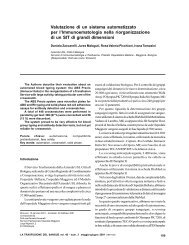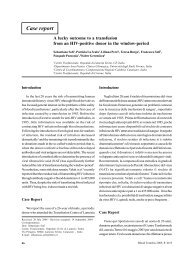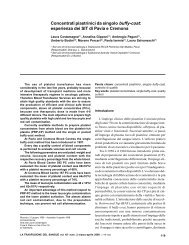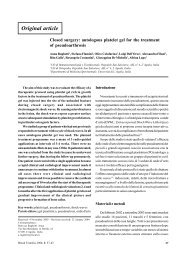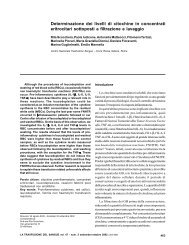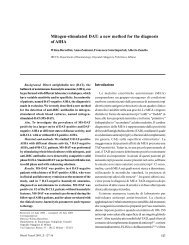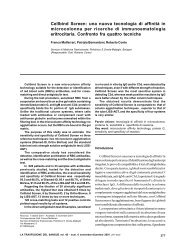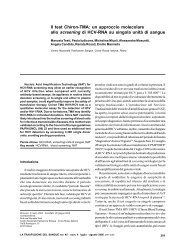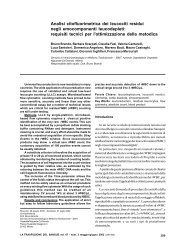Mathematics and transfusion medicine - Blood Transfusion
Mathematics and transfusion medicine - Blood Transfusion
Mathematics and transfusion medicine - Blood Transfusion
You also want an ePaper? Increase the reach of your titles
YUMPU automatically turns print PDFs into web optimized ePapers that Google loves.
Giampaolo A et al."dealing with blood", could represent the context inwhich to spread the culture of haemovigilance, makingcollaboration between TS <strong>and</strong> hospital wards morepossible 11 .MethodsThe collection of haemovigilance data is theresponsibility of the 326 Italian TS distributedthroughout the country <strong>and</strong> located within hospitals 12 .Inside the TS, blood is donated, tested <strong>and</strong> processedto produce the blood components, that are then sentto the wards; the TS must then receive, from the doctorwho uses the <strong>transfusion</strong> therapy, documentation onevery <strong>transfusion</strong> <strong>and</strong> any adverse reactions (article15, paragraph 3 in 13 ).The TS store <strong>and</strong> manage the information, fillingin the computerised PETRA form for every caseidentified. The records are periodically sent to theCRCC, which then transmit the regional data to theISS. The data collected can be used at local, regional,national <strong>and</strong> international levels.The haemovigilance system calls for theregistration of immediate <strong>transfusion</strong> reactions(haemolysis, TRALI, bacterial contamination,anaphylactic shock, etc.), late effects [haemolysis,graft-versus-host disease (GvHD), post-<strong>transfusion</strong>alpurpura, etc.] <strong>and</strong> <strong>transfusion</strong> of wrong bloodcomponents.The system is also designed to collect informationon near miss errors, that is, mistakes recognised beforethe <strong>transfusion</strong>, which could have led to the<strong>transfusion</strong> of a mistaken blood group or theregistration, collection or management of a wrong,inappropriate or unusable blood component.The information required by the PETRAnotification form are those considered minimum byRecommendation R(95)15 14 ; that is: (a) date of birth,sex <strong>and</strong> identification code of the patient transfused;(b) number of the units <strong>and</strong> identification codes ofthe blood components involved in the adverse event;(c) description of the type of blood component, itsmethod of preparation <strong>and</strong> the conditions <strong>and</strong> durationof storage of the blood component prior to its<strong>transfusion</strong>; (d) severity of the event, reportedaccording to a graded scale (mild symptoms, longtermmorbidity, immediate threat to life, death); (e)imputability, that is, the relation between theunfavourable effects observed <strong>and</strong> the bloodcomponent transfused, using a graded scale.The PETRA forms sent by the Region of Piemonteare filled in electronically, interfacing the PETRAsoftware with that of the "Form for recording adverseevents of <strong>transfusion</strong> therapy", used by the Region.The incidence of adverse events was calculatedbased on the number of units of blood componentsdistributed, which is monitored by the National <strong>and</strong>Regional Register of <strong>Blood</strong> <strong>and</strong> Plasma 15 .ResultsSurvey of adverse events in 2005In 2005, the percentage of the 326 Italian TS thatparticipated in the haemovigilance survey was 38.4%,which was almost double that in 2004 (21.0%). Thispercentage also includes the TS that did not usePETRA <strong>and</strong> those that stated the absence of adversereactions.Table I reports the percentage participation in2004-2005. The regions in which all the TSparticipated in 2005 survey were Friuli-VeneziaGiulia, Liguria, Lombardia, the Marche, Piemonte,the Autonomous Province of Bolzano <strong>and</strong> Valled'Aosta; the coverage in military TS was 100%. Therate of responses was high in Lazio <strong>and</strong> Veneto.Considering the number of units of bloodcomponents distributed in 2005 by the TS, whichwere included in survey (1,834,474), the systemmonitored 49.6% of the units distributed in Italy(3,701,724) (Figure 1).In 2005, there were reports of 1,495 adversereactions, 823 of which were reported using asummary data-sheet other than PETRA, such that, inmost cases of events notified, a description of thecausative role of the <strong>transfusion</strong> in the adverse reactionwas not given.Overall, 0.8 reactions were reported every 1,000units of blood components distributed.Almost all the adverse events reported were acute:46.9% of the reactions were febrile type reactions <strong>and</strong>38.7% were of an allergic nature (urticaria <strong>and</strong>anaphylactic reactions). Only six delayed type adversereactions were reported: four late haemolyticreactions, one case of GvHD <strong>and</strong> one HIV infection(Figure 2).The collection of data carried out with differentmethods by the structures that participated in thehaemovigilance system in 2005 was not homogenous<strong>and</strong> did not enable further analysis.68<strong>Blood</strong> Transfus 2007; 5: 66-74 DOI 10.2450/2007.0001-07066-074_hassan.p65 6805/07/2007, 10.44



